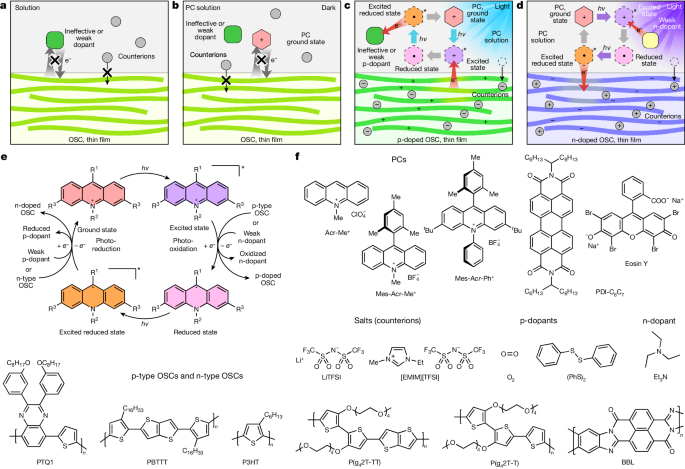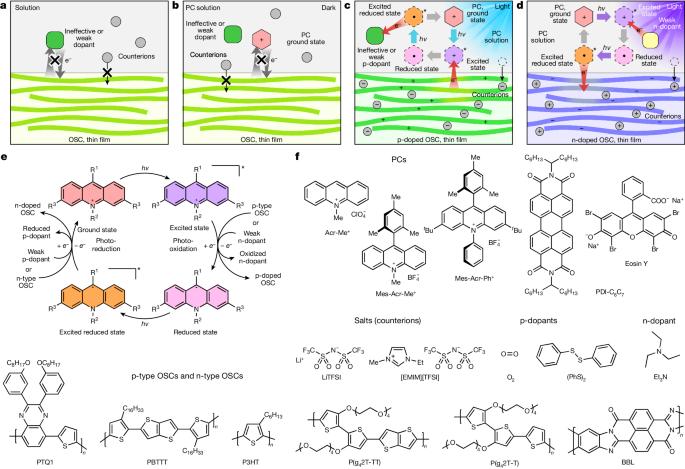有机半导体的光催化掺杂。
IF 50.5
1区 综合性期刊
Q1 MULTIDISCIPLINARY SCIENCES
引用次数: 0
摘要
化学掺杂是操纵有机半导体(OSC)1-3 中电荷载流子浓度和传输的重要方法,并能最终提高器件性能4-7。然而,传统的掺杂策略通常依赖于使用高活性(强)掺杂剂8-10,这些掺杂剂在掺杂过程中会被消耗掉。在温和条件下使用弱掺杂剂和/或可广泛获得的掺杂剂实现高效掺杂仍然是一个相当大的挑战。在此,我们报告了一种以前未曾描述过的 OSC 光催化掺杂概念,它使用空气作为弱氧化剂(p-掺杂剂),并在室温下运行。这是一种通用方法,可应用于各种 OSC 和光催化剂,其电导率超过 3,000 S cm-1。我们还展示了成功的光催化还原(n-掺杂)以及同时对 OSCs 进行 p 掺杂和 n 掺杂的方法,其中用于维持电荷中性的有机盐是唯一消耗的化学物质。我们的光催化掺杂方法为促进 OSC 掺杂和开发下一代有机电子器件提供了巨大的潜力。本文章由计算机程序翻译,如有差异,请以英文原文为准。


Photocatalytic doping of organic semiconductors
Chemical doping is an important approach to manipulating charge-carrier concentration and transport in organic semiconductors (OSCs)1–3 and ultimately enhances device performance4–7. However, conventional doping strategies often rely on the use of highly reactive (strong) dopants8–10, which are consumed during the doping process. Achieving efficient doping with weak and/or widely accessible dopants under mild conditions remains a considerable challenge. Here, we report a previously undescribed concept for the photocatalytic doping of OSCs that uses air as a weak oxidant (p-dopant) and operates at room temperature. This is a general approach that can be applied to various OSCs and photocatalysts, yielding electrical conductivities that exceed 3,000 S cm–1. We also demonstrate the successful photocatalytic reduction (n-doping) and simultaneous p-doping and n-doping of OSCs in which the organic salt used to maintain charge neutrality is the only chemical consumed. Our photocatalytic doping method offers great potential for advancing OSC doping and developing next-generation organic electronic devices. A previously undescribed photocatalytic approach enables the effective p-type and n-type doping of organic semiconductors at room temperature using only widely available weak dopants such as oxygen and triethylamine.
求助全文
通过发布文献求助,成功后即可免费获取论文全文。
去求助
来源期刊

Nature
综合性期刊-综合性期刊
CiteScore
90.00
自引率
1.20%
发文量
3652
审稿时长
3 months
期刊介绍:
Nature is a prestigious international journal that publishes peer-reviewed research in various scientific and technological fields. The selection of articles is based on criteria such as originality, importance, interdisciplinary relevance, timeliness, accessibility, elegance, and surprising conclusions. In addition to showcasing significant scientific advances, Nature delivers rapid, authoritative, insightful news, and interpretation of current and upcoming trends impacting science, scientists, and the broader public. The journal serves a dual purpose: firstly, to promptly share noteworthy scientific advances and foster discussions among scientists, and secondly, to ensure the swift dissemination of scientific results globally, emphasizing their significance for knowledge, culture, and daily life.
 求助内容:
求助内容: 应助结果提醒方式:
应助结果提醒方式:


